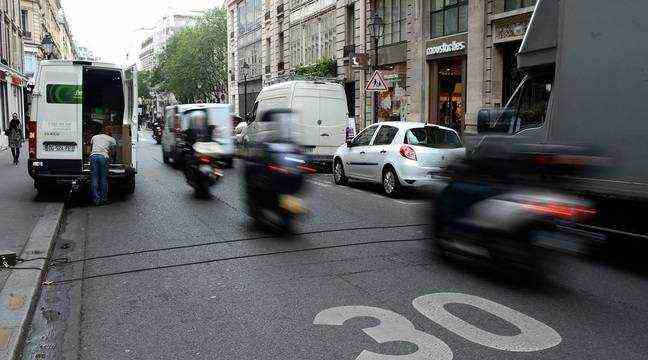For some motorists, driving at 30 km / h in Paris is far from easy. Readers of 20 minutes Many responded to our call for testimonies after the announcement of the entry into force on August 30 of this limitation in most of the streets of Paris. Some axes will escape the rule: the ring road, but also the boulevards des Maréchaux and the avenues of the Bois de Boulogne and Vincennes, the Champs-Elysées, the avenue Foch, the avenue de la Grande Armée and the rue Royale, which will remain limited to 70 km / h for the first one and 50 km / h for the following ones.
Introduced by the elected ecologist David Belliard, deputy mayor of Paris in charge of the transformation of public space, transport, mobility, the Code of the streets and highways, this decision follows another consultation online on the generalization of 30 km / h, launched by the mayor of Paris at the end of 2020. Out of 5,736 responses (63% of Parisians), 59% of Parisians were in favor
according to figures put forward by the municipality, while 61% of Ile-de-France residents were against. A divide that emerges from the responses sent to the editorial staff of 20 minutes to the question “the 30 km / h in almost all the capital, will they change anything? “
More caps for more pollution
Many readers, including César, 51, have expressed their annoyance, believing that this limitation will lead to an “increase in pollution already too present”, and fear “additional traffic jams”. “We no longer understand what ecology is,” estimates Ghasmi (28 years old). We were advised to let go of our [voitures] petrol and diesel for expensive hybrids and electrics. All for nothing because it is getting harder and harder to move around in Paris. “
The risk of a transfer of vehicles to major axes also worries François (42) for whom the limitation “will push motorists to take the boulevards of Maréchaux, already overcrowded due to the limits on the ring road”. A fear shared by Marie-José (50), who lives on a “boulevard bordering the ring road” and considers herself “left behind”: “We already have all the noise pollution from the ring road which had to be reduced by a special coating , which has never been done. Now the City of Paris wants to divert all cars traveling at more than 30 km / h on circular boulevards without taking into account the nuisance that this will still generate for those who live there. “
An “exclusion of suburbanites”
Although the 30 km / h are already applied in 60% of the capital, the support is not numerous past the periphery. Daphne (42) sees it as “a daily nightmare for people who do not have the privilege of having public transport at their doorstep”. She adds “trains or the RER are too dangerous at night, only the car can ensure relative safety and speed to return home”. Octave (35) speaks of a feeling of “exclusion of suburbanites”. While Didier (55) is “discouraged”: “It has become impossible to come and make bulky purchases in Paris, or to go to a show or an event that ends late. Before the car allowed it. Now it’s too complicated, too stressful and too expensive. “
For Stéphane, 46, public transport cannot be an alternative to the car, it “is poorly organized when it is not on strike. “” The offer is too limited “to respond to the” pendulum movement between the city and its immense suburb “, according to Rémi (65). “We must think about how to replace car trips, rather than systematically penalizing motorists,” says Isabelle, 51 years old.
But the measure does not only have detractors. For Carlos, a 61-year-old commuter, “this is in line with the demand for less pollution, and a better quality of life everywhere. “And safety is a strong argument for Anne (65), who thinks that” it will reduce the number of deaths, pedestrians and two-wheelers. At 30 km / h, you can brake more easily and in the event of an accident it will be much less serious. “
The difficulty of enforcing 30 km / h
“We must generalize this measure, says Christian (65), certainly very restrictive but essential for the well-being and especially the health of the inhabitants. “Pierre, thirty years younger, recognizes:” it is a necessary measure to reduce road mortality and noise pollution “because” at 30 km / h, the survival rate is 70% while it is 20% at 50 km / h ”. The difficulty lies in the application of the measure. “I think that this will not change much in practice because speed controls are non-existent and arrangements to break the speed, especially near schools or pedestrian areas are too rare. “
On this point, David Belliard announces to 20 minutes : “We will not accept uncivil behavior that puts the lives of pedestrians and cyclists in danger. We are going to work with the police headquarters so that there are stronger controls in terms of speeding, from the start of the school year. There is a matter of good control. “
Last point of contention, the gap in supervision measures between motorists and drivers of bicycles and scooters. For Améthiste (60 years old), “between work everywhere, bicycles and scooters which do not respect anything, pedestrians who cross without looking at anything especially with headphones on their ears, there are fewer and fewer possibilities to move around” . Anne wants bicycles and scooters to be “fined” when they “burn red lights and brush against you when you cross at the pedestrian crossing”.

